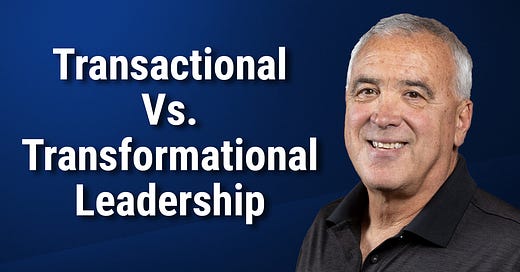Transactional Vs. Transformational Leadership: How to Bridge Between the Two
Insights from Bruce Avolio, Professor of Management
Are you a transactional leader or a transformational leader?
My interview today is with Bruce Avolio, the former Director of the Gallup Leadership Institute, renowned expert in the field of leadership, and Professor of Management at the University of Washington Foster School of Business. Bruce has dedicated his career to studying leadership and developing strategies for effective leadership in today's rapidly changing world.
In our conversation, we explore the topic of leadership and how to become a successful leader. Bruce shares his insights on the debate of whether leaders are born or made, and emphasizes the importance of self-awareness and innovation for leaders. He also highlights the growing emphasis on psychological safety in the workplace and the value of authenticity in leadership. As the name implies, transactional leaders prioritize day-to-day tasks and transactions to get work done. They focus on driving the business forward with efficient processes and moving the needle with tasks and metrics.
According to Bruce, both types of leaders are crucial for modern companies. It isn’t an either/or situation. The best leaders are the ones who can bridge transactional and transformational leadership.
As the name implies, transactional leaders prioritize day-to-day tasks and transactions to get work done. They focus on driving the business forward with efficient processes and moving the needle with tasks and metrics.
On the other hand, transformational leaders prioritize the bigger picture and innovation. Their goal is to change and improve their companies and people with large-scale solutions. It’s not about incrementally changing a company but leading large shifts and total transformations.
The old way of thinking is that leaders were either transactional or transformational. But Bruce and his colleagues proved that is no longer the case. Leaders can be both transactional and transformational. In fact, it is optimum to be both. You have to be transactional and get things done to provide deliverables to other teams and employees. Even with a big-picture focus, daily work still has to get done. Bruce likens it to getting the trains to run safely and stay on the tracks. Everything happens in the world through good transactions, and most leaders spend the bulk of their days on transactional work.
This is a free post. Become a paid subscriber and and start your day with the world’s top leaders, thinkers, and authors. Get access to exclusive interviews, leadership insights, research, and videos to excel your leadership and professional development journey!
But to make the most of their careers, companies, and people, transactional leaders need to cross over and embrace transformational leadership. The bridge to transformational leadership is when leaders realize the potential of their ideas and people.
Bruce says there are four aspects of moving to transformational leadership:
Focus on individuals. Transformational leaders get to know their people individually to understand their strengths and weaknesses. A transformational leader tries to be a steward of someone’s development. They are genuine and see the potential of who that person could become.
Challenge assumptions. Transformational leaders think about the possibilities for their people and their companies. Instead of sticking with the status quo, they think big. They challenge the assumptions and frameworks. Bruce gives the example of a leader transforming the company from the typical delivery by trucks to delivering products by drones.
See more potential. Instead of being content with where things are, transformational leaders push for something better. Just because things are fine doesn’t mean they can’t be improved and your message can’t be shared with more people.
Build trust. People have to trust and believe in transformational leaders so they want to come on the journey. Bruce says the highest end of transformational leadership is the morals, ethics, and values that help people more than any reward the leader will ever get.
Leadership is about transactions and transformation: you have to get daily tasks done to keep the company moving, but you also have to see the big picture and be willing to make big moves to transform and disrupt.
Leaders who can see the potential of their people, build trust, and challenge assumptions will cross that bridge from transactional to transformational leadership and thrive in the future of work.






